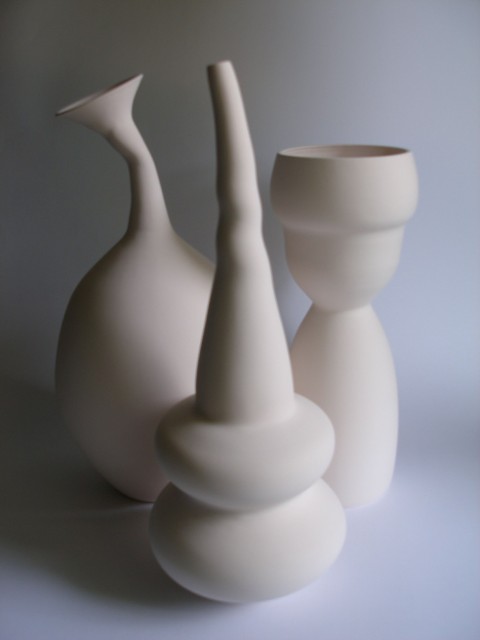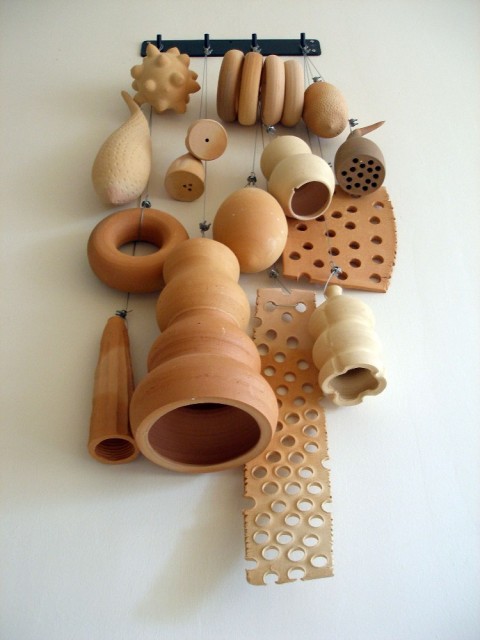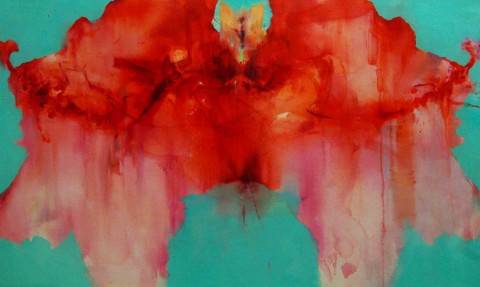

It is only when facing an art work that one uncovers great truth: words are always too poor, too conventional and remarkably incomplete when it comes to telling the stories a piece of art can tell. This truth is exactly what Shalini Ganendra Fine Arts emphasizes in the new exhibition, What goes up, showcasing the works of four award winning local artists. The works explore the incompleteness of that phrase.
The paintings of Yeoh Kean Thai, Shia Yih Yiing, Zac Lee, and the beautifully crafted ceramics of Lileng Wong, will impress viewers, leading audiences to carefully examine the strokes, colours and shapes, and participate in the artists’ interpretations of the unfinished title phrase.

Generation Flow, 2009, Mixed media on canvas
Yeoh Kean Thai’s four paintings, done specifically for the show, consist of two complimentary pairs: Generation Flow and Generation Jump, and Land and Sky. Each one completes its other half. The first pair investigates the flow of generations, referring to vernacular symbolism: a fish representing the artist’s father, and a praying mantis to portray the painter himself.
Land and Sky, on the other hand, both present a series of seven hinges each, on an earth toned background for the land, and a fusion of light blue and white strokes for the sky. The hinges are meant to metaphorically keep the two paintings bound together, allowing one to look up to the sky, have dreams, but not forgetting to stay down to earth.
Why seven of them? ‘I have noticed that there is something about the number Seven: the seven continents, the seven sins, the seven revelations in the Bible, the seven wonders of the world, the seven colours of the rainbow, the seven days of the week, etc. It could easily be considered as a mystical number and this mystery fascinates me’, says the artist.
These pieces develop Thai’s mantra, creating an aesthetic language based largely on metal and rust, to voice deep concerns primarily about environment and social issues.
Thai’s unique style has earned him international recognition through prestigious awards, including the Commonwealth Award.

Abstract Directions, 2009, Porcelain unglazed
Lileng Wong has a number of works in this show. The six porcelain and clay vases resemble family members. The largest standing piece is made of local earthen brown clay with blue glaze, and is accompanied by a piece made out of local earthen white clay, with dark blue line decoration. The glazing technique reflects Wong’s mastery with materials.
She has also included four unglazed porcelain works which explore her theme of ‘in between spaces’.
As pointed out by Wong, these works, when presented in a grouping, allow other invisible shapes to appear through the negative space created. In her recent works, Lileng Wong intends to express the nuance of shape by creating balance in shape, dimension and form, so as to convey mood, atmosphere and feeling through the pots.
 Cascade Down, 2009, Ceramic Installation of different fired clay compositions
Cascade Down, 2009, Ceramic Installation of different fired clay compositions
The highlight for this show is a large installation of ceramics, made out of both white and brown clay, representing a number of organic forms. Some of the objects represent seeds and fruits from her native Sabah. Others, man-made objects that challenge the continuance of natural orders.
Harmony is present in this composition, where the diverse forms, shapes and hues are thoughtfully arranged to create intrigue and balance.

Sarong of Unity, 2009, Oil and acrylic on canvas
Are the three fairy godmothers from Shia Yih Yiing’s paintings part of the audience? One might have this impression, as the intense but delicate look of these women are powerful enough to command the center of the show.
The three Fairy Godmothers are very different, each of them wearing different sarongs, which lead to the titles of the pieces: Sarong of Joy, Sarong of Abundance and Sarong of Peace. Common points are the magic wand in one hand, and a mango in the other one. Shia Yih Yiing’s Godmother characters are an Asian reinterpretation of fairytale magic and darkness, providing both magical help and the poisoned fruit.
Shia’s style, which could be defined as sentimental, metaphorical and playful, is used to illustrate themes such as fantasy, family, motherhood, and, more recently, a national concern:
‘As I see my children grow up, I start feeling more and more concerned about our national issues. Through my work, I try to speak out in my own way.’
The use of fairy tales adeptly conveys her thoughts, emotions, as well as her engagement outside the family world. It operates as a poetic resistance.
Combining roles of mother, wife, teacher and artist at the same time is not a stumbling block for Shia: her everyday experience in each one of them inspires her work, giving it this sentimental touch.
On the opposite wall, facing Shia Yih Yiing’s work, is Zac Lee’s Hibiscus Series. These five semi-realist paintings explore the meaning of the national flower, the hibiscus, through different colours, painting techniques and representations. Lee works with oil on jute which gives a wonderful depth and transparency to the works.
 Mirror Image, 2009, Oil on jute, 90cm x 150cm
Mirror Image, 2009, Oil on jute, 90cm x 150cm
Twin Grey, Twin Blue and Twin Red uses a mirror effect. They remind me of a painting technique used by children: put paint on paper, then fold it in two, and when opened it reveals an abstract but symmetrical form. Or perhaps, psychological ink tests.
The painting, Green Hibiscus, is the only one whose flower has pistils pointing down and not up. Painted with translucent green/yellow strokes on a background of tonal blues, it is the most literal and disturbing of the series.
‘Everyone is used to the hibiscus being red. By showing it in different colours than the original flower, I want to trigger interrogation in the viewer’s mind. To enhance such reaction, I also try to blur the strokes, so that the subject’s implication may be questioned as well. I do not have an official interpretation for my paintings. What is great about art, is that everyone has their own perception of it, and it is precisely this diversity of interpretations that I want my work to allow.’
This series is very characteristic to Lee’s style: his work often involves inquiry into Malaysian folklore and national iconography, through experimentation with abstraction and realism.
For more information, please visit : www.shaliniganendra.com. To view, please phone +603 7958 2175.
~
Sylvia Degiacomi is in her second year of a French Literature Degree at the Sorbonne University in Paris. Conducting her course by long distance, she is traveling the world collecting new experiences and stories to share with audiences along the way.
Sorry, the comment form is closed at this time.
Very interesting article, really, one would like to visit your gallery and see the exhibition.
If I can manage in february 2010, it would be a pleasure to visit your gallery in Kuala Lumpur during my trip to Asia.
Yours sincerely
Martha Degiacomi
Art Historian
Fondation Pierre Gianadda
CH – 1920 Martigny
Switzerland